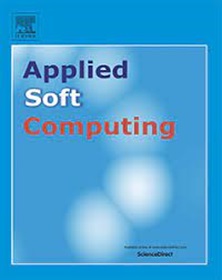Clustering by detecting skeletal structure and identifying density fluctuation
IF 7.2
1区 计算机科学
Q1 COMPUTER SCIENCE, ARTIFICIAL INTELLIGENCE
引用次数: 0
Abstract
Clustering is one of the most important techniques for unsupervised learning, it tries to divide points into different clusters without any priori knowledge of data. Therefore, several criterions for clustering algorithm are as follows: 1. Handling clusters with arbitrary shape and various density; 2. Finding cluster centers automatically; 3. Low parameter sensitivity and computational complexity. In this context, a novel algorithm namely clustering by detecting skeletal structure and identifying density fluctuation (CSSDF) was presented. In CSSDF, an efficient strategy based on density and local information of neighborhood is firstly proposed to detect the skeletal structure, which can collect the local information and identify the rough distribution of data. With the identified distribution information, a method takes expanded neighborhood and density fluctuation into consideration is proposed to further collect global information of data, which can assign all skeleton points and find cluster centers. To sum up, CSSDF can not only discover the underlying structure of data regardless of its’ distribution, but also ensure the correct assignment of all skeleton points and thus lead to a satisfying clustering performance. In addition, the computational complexity of the proposed approach is , which makes it possible to deal with some large clustering problem.
通过检测骨骼结构和识别密度波动进行聚类
聚类是无监督学习中最重要的技术之一,它试图在没有任何先验数据知识的情况下将点划分为不同的聚类。因此,聚类算法的几个标准如下:1.2.自动寻找聚类中心;3.低参数敏感性和计算复杂度。在此背景下,一种新型算法,即通过检测骨架结构和识别密度波动进行聚类(CSSDF)被提出。在 CSSDF 中,首先提出了一种基于密度和邻域局部信息的高效策略来检测骨架结构,从而收集局部信息并识别数据的粗略分布。在确定分布信息的基础上,提出一种考虑扩展邻域和密度波动的方法,进一步收集数据的全局信息,从而分配所有骨架点并找到聚类中心。总之,CSSDF 不仅能发现数据的底层结构(无论其分布如何),还能确保所有骨架点的正确分配,从而获得令人满意的聚类性能。此外,所提方法的计算复杂度为 O(nlogn),这使得处理一些大型聚类问题成为可能。
本文章由计算机程序翻译,如有差异,请以英文原文为准。
求助全文
约1分钟内获得全文
求助全文
来源期刊

Applied Soft Computing
工程技术-计算机:跨学科应用
CiteScore
15.80
自引率
6.90%
发文量
874
审稿时长
10.9 months
期刊介绍:
Applied Soft Computing is an international journal promoting an integrated view of soft computing to solve real life problems.The focus is to publish the highest quality research in application and convergence of the areas of Fuzzy Logic, Neural Networks, Evolutionary Computing, Rough Sets and other similar techniques to address real world complexities.
Applied Soft Computing is a rolling publication: articles are published as soon as the editor-in-chief has accepted them. Therefore, the web site will continuously be updated with new articles and the publication time will be short.
 求助内容:
求助内容: 应助结果提醒方式:
应助结果提醒方式:


